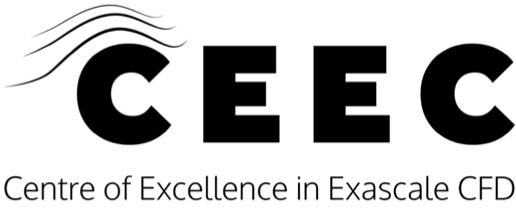CEEC: Centre of Excellence for Exascale CFD
Niclas Jansson, PDC

For many centuries, scientific discovery relied on performing experiments and the subsequent deduction of new theoretical models. The advent of powerful computers, coupled with new and ever more efficient numerical algorithms, makes it possible to simulate complex systems with increasing realism and to automatise even model discovery using AI technologies. Computational Fluid Dynamics (CFD) is one of the most prominent areas that clearly requires and even motivates exascale computing to be part of the engineering and academic workflows. Given the physical scaling and the availability of highly efficient simulation codes, CFD is one of the few application areas that has the potential of reaching exascale performance in the near future.
CEEC is a recently started centre of excellence (CoE) for high-performance computing (HPC) applications, co-funded by the European High Performance Computing Joint Undertaking (EuroHPC JU). The centre is currently funded from the start of 2023 to the end of 2026. One of CEEC’s main purposes is to implement exascale-ready workflows for addressing relevant challenges for future exascale systems, including those procured by EuroHPC. This includes facilitating significant improvements in energy efficiency through the efficient exploitation of accelerated hardware architectures based on graphics processing units (GPUs) and utilising novel adaptive mixed-precision calculations. Emphasis will furthermore be given to new or improved algorithms, which will be necessary for exploiting upcoming exascale architectures.
The work of CEEC is driven by a collection of six different lighthouse cases of physical and engineering interest, ranging from aeronautical to atmospheric flows, with the goal of reaching a technology readiness level (TRL) of four and even five for selected cases. These are the lighthouse cases chosen to illuminate future developments.
- Two aeronautic cases look at questions like why we have in-flight turbulence and how to make plane wings more efficient without risking structural safety.
- Topology optimisation of static mixers (which use the internal shape of a pipe to mix fluids without any moving parts) considers issues like what is the best pipe shape for mixing fluids.
- Localised erosion of an offshore wind turbine foundation investigates ways to minimise negative environmental impacts from the installation of wind turbines.
- Simulation of Atmospheric Boundary Layer (ABL) flows works on understanding and predicting ABL flows to optimise, for example, solar energy production and weather modelling.
- Merchant ship hull will improve simulations of water and air flow around ships.
All the CEEC software development for these cases is being done in five European HPC codes which span the entire spectrum of CFD applications, including compressible, incompressible and multiphase flows.
PDC is coordinating CEEC and leading the management work package, while the technical work is being performed in collaboration with several research groups and centres. The KTH Royal Institute of Technology brings in the merchant ship hull lighthouse case, as well as the spectral element code Neko. With expertise in application development and optimisation, KTH contributes to the software and performance engineering work package and leads the software engineering and software deployment tasks. Furthermore, KTH will work on exascale algorithms and is leading the efforts on fault-resilient algorithms, as well as adaptivity and error control. Finally, KTH leads the efforts to explore quantum computing as a forward-looking technology.
For more information about CEEC and the lighthouse cases, see ceec-coe.eu .
